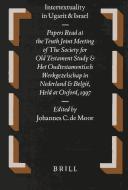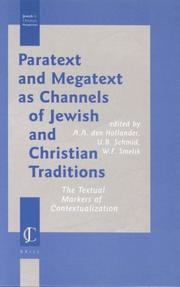| Listing 1 - 8 of 8 |
Sort by
|

ISSN: 01697226 ISBN: 9004103651 9004494707 9789004103658 9789004494701 Year: 1995 Volume: 36 Publisher: Leiden New York : E. J. Brill,
Abstract | Keywords | Export | Availability | Bookmark
 Loading...
Loading...Choose an application
- Reference Manager
- EndNote
- RefWorks (Direct export to RefWorks)
This book forms a contribution to the vexing question of the origin and growth of the Targum to the Prophets. It provides an in-depth analysis of the Targum of Judges on the basis of new materials (unpublished manuscripts), a new tool (bilingual concordance) and a new method (analysis of consistency). A critical review of previous research concerning the Targum's origin and growth is followed by an analysis and collations of many Western manuscripts, a systematic comparison of the Targum with the ancient translations, a study of its exegetical traditions and a thorough examination of its consistency. On this basis it is suggested that the Targum assumed its basic form in the second century CE, due to the emergency of the rabbinic tradition, but outside the context of the synagogue.
Bible --- Commentaries --- Translations into English --- Bible. --- Commentaries. --- Translations into English. --- 221.014*2 --- 296*12 --- 222.5 --- Oud Testament: geschiedenis van grondtekst en oude vertalingen --- Targum --- Jozua. Rechters. Ruth --- 296*12 Targum --- 221.014*2 Oud Testament: geschiedenis van grondtekst en oude vertalingen --- Targum of the Judges --- Bible. - O.T. - Judges - Aramaic - Targum Pseudo-Jonathan - Commentaries. --- Bible. - O.T. - Judges - Aramaic - Targum Pseudo-Jonathan - Translations into English. --- Bible. A.T.. Prophètes --- Bible. A.T.. Juges --- Versions araméennes --- Targum de Jonathan --- Versions --- Biblical Studies --- Exegesis
Book
ISBN: 9781107026216 9781107473058 9781139206969 9781461953555 1461953553 1139206966 9781107464926 1107464927 1107473055 1107026210 1139892118 1107461065 1107472032 1107468418 1306211786 Year: 2013 Publisher: Cambridge
Abstract | Keywords | Export | Availability | Bookmark
 Loading...
Loading...Choose an application
- Reference Manager
- EndNote
- RefWorks (Direct export to RefWorks)
Exposed to multiple languages as a result of annexation, migration, pilgrimage and its position on key trade routes, the Roman Palestine of Late Antiquity was a border area where Aramaic, Greek, Hebrew and Arabic dialects were all in common use. This study analyses the way scriptural translation was perceived and practised by the rabbinic movement in this multilingual world. Drawing on a wide range of classical rabbinic sources, including unused manuscript materials, Willem F. Smelik traces developments in rabbinic thought and argues that foreign languages were deemed highly valuable for the lexical and semantic light they shed on the meanings of lexemes in the holy tongue. Key themes, such as the reception of translations of the Hebrew Scriptures, multilingualism in society, and rabbinic rules for translation, are discussed at length. This book will be invaluable for students of ancient Judaism, rabbinic studies, Old Testament studies, early Christianity and translation studies.
Rabbinical literature --- Translating and interpreting --- Jews --- Judaism --- 933.51 --- Hebrews --- Israelites --- Jewish people --- Jewry --- Judaic people --- Judaists --- Ethnology --- Religious adherents --- Semites --- Interpretation and translation --- Interpreting and translating --- Language and languages --- Literature --- Translation and interpretation --- Translators --- Hebrew literature --- Jewish literature --- 933.51 Geschiedenis van het Joodse volk: Romeinse tijd II--(70-325) --- Geschiedenis van het Joodse volk: Romeinse tijd II--(70-325) --- Translating. --- Translations. --- History --- Languages --- History. --- Translating --- Translations --- Languages&delete& --- History and criticism. --- Arts and Humanities --- Religion
Book
ISBN: 9004104623 Year: 1996 Publisher: Leiden Brill
Abstract | Keywords | Export | Availability | Bookmark
 Loading...
Loading...Choose an application
- Reference Manager
- EndNote
- RefWorks (Direct export to RefWorks)
Digital
ISBN: 9781139206969 Year: 2013 Publisher: Cambridge Cambridge University Press
Abstract | Keywords | Export | Availability | Bookmark
 Loading...
Loading...Choose an application
- Reference Manager
- EndNote
- RefWorks (Direct export to RefWorks)
Translation science --- Yiddish language --- Yiddish literature

ISBN: 9004128824 9004421432 9789004128828 Year: 2003 Volume: 6 Publisher: Leiden, The Netherlands ; Boston : Brill,
Abstract | Keywords | Export | Availability | Bookmark
 Loading...
Loading...Choose an application
- Reference Manager
- EndNote
- RefWorks (Direct export to RefWorks)
Religious traditions are channeled to new audiences by textual markers, which inform their understanding and influence. Such markers are signs of contextualisation which belong to the paratext of a tradition: textual elements that do not belong to the core text itself but belong to their embedding and as such affect their reception. Alternatively, some texts function purposely in tandem with another text, and cannot be understood without that text. While the second text informs the way the first one is being understood, it can hardly function independently. The discussions include the arrangement of textual blocks in the Hebrew Bible; how the oral transmission of Jewish Aramaic Bible translations had to be recited as a counterpoint to the Hebrew chant; how synagogue poetry presupposes the channels of liturgical instruction; how the Talmud can be perceived as a translation of Mishnah; how the presence of paratextual elements such as annotations and prefaces influenced the Index Librorum Prohibitorum concerning 16th century Bibles; the function of paratext and scope for modern Bible translations. This volume will tentatively explore the wide range of paratext and megatext as devices of channeling religious traditions.
Bible --- Versions --- Congresses. --- Criticism, interpretation, etc. --- Congrès --- Critique, interprétation, etc. --- 22.05 --- Bijbel: oude vertalingen, belangrijk voor de tekstgeschiedenis--(algemeen) --- Conferences - Meetings --- Congrès --- Critique, interprétation, etc. --- Biblia --- Versions.
Dissertation
Year: 1995 Publisher: Leiden Brill
Abstract | Keywords | Export | Availability | Bookmark
 Loading...
Loading...Choose an application
- Reference Manager
- EndNote
- RefWorks (Direct export to RefWorks)
Book

ISBN: 1463210124 Year: 2005 Publisher: Piscataway, NJ : Gorgias Press,
Abstract | Keywords | Export | Availability | Bookmark
 Loading...
Loading...Choose an application
- Reference Manager
- EndNote
- RefWorks (Direct export to RefWorks)
This work consists of a selection of papers from sessions during the first two years of SBL Consultation on Midrash. It demonstrates innovative approaches to midrashic texts and hermeneutic reflections on similarities and differences between interpretations of the Bible.
Book

ISBN: 9781463215941 Year: 2008 Publisher: Piscataway, NJ
Abstract | Keywords | Export | Availability | Bookmark
 Loading...
Loading...Choose an application
- Reference Manager
- EndNote
- RefWorks (Direct export to RefWorks)
| Listing 1 - 8 of 8 |
Sort by
|

 Search
Search Feedback
Feedback About UniCat
About UniCat  Help
Help News
News